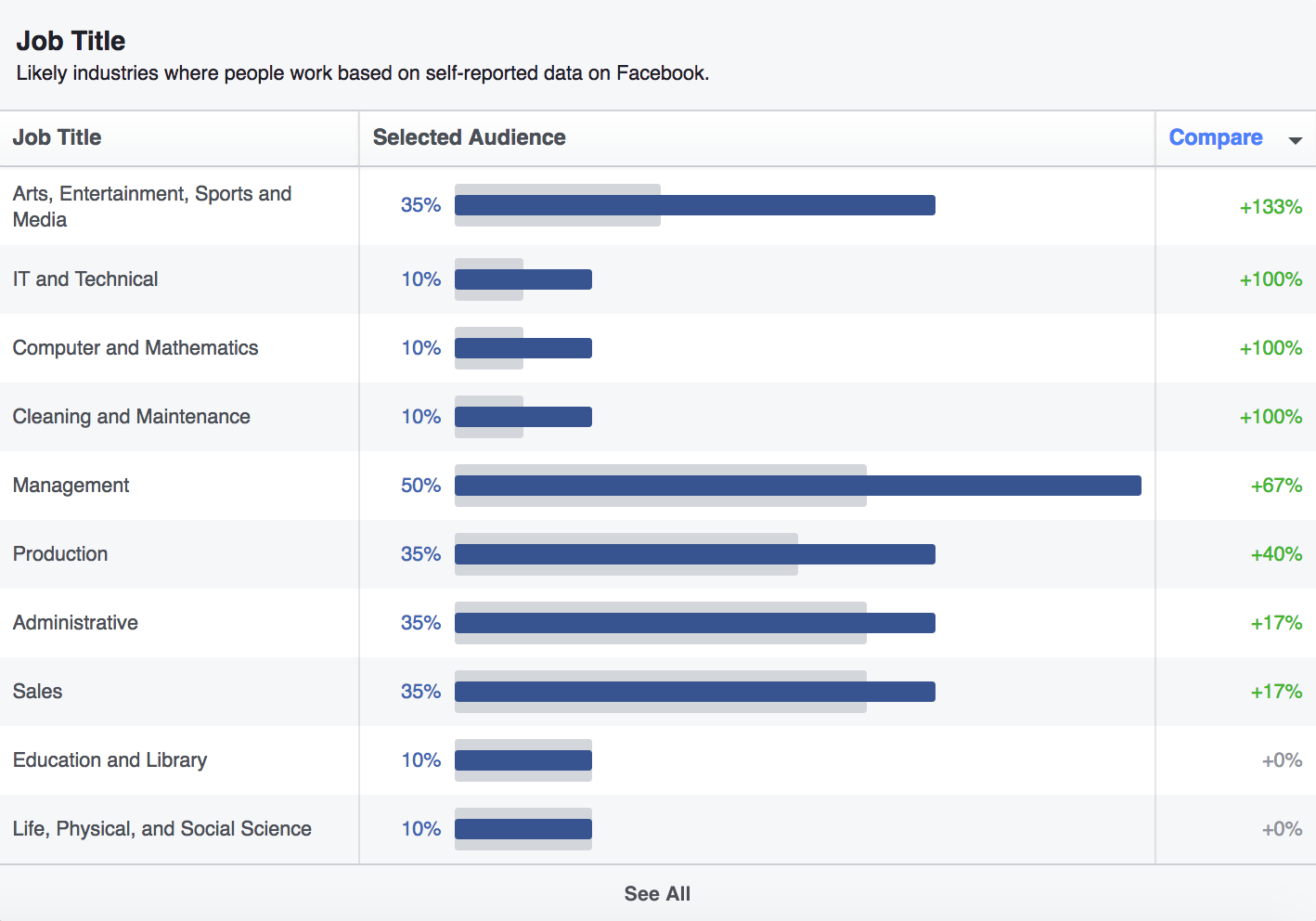So you’ve decided to market your brand on Facebook. Wise choice. No matter what industry you’re in, Facebook marketing really isn’t optional.
Today, neglecting Facebook is like not having a website in the 2000s, or not being in the yellow pages before that. It’s just too popular to ignore.
So since you need to be present on Facebook, we want to make sure you make the most of it.
These 9 keys will ensure that you’re engaging with users, posting great content, and generally killing it on Facebook.
Let’s get into it!
This post is long. Want the 30-second version? Download this checklist!
1. Understand your audience
Learn how to talk to people by knowing who you’re talking to. Your Facebook marketing will be far more effective if you know what makes your audience tick.
Thankfully, Facebook (like other social media platforms) gives you the resources you need.
Get to know Facebook’s Ads Manager
We’ll talk more about the value of Facebook advertising soon. But even if you don’t plan to advertise, Facebook’s tools are useful. Ads Manager lets you target custom audiences based on their interests, gender, location, and just about anything else.
You can use this even if you don’t intend to pay for ads. Segment your audience as if you were going to post commercials, and see what kinds of interesting people follow you already.
In Ads Manager, go to Audience Insights, and select “Create New”:

To learn more about the people already following you, select the second option. You’ll get a breakdown including gender, education, and job title for your fans:

You’ll quickly discover more about your audience to help tailor your content to their needs. This is perfect for marketers who want to really connect with their followers, and find new ones.
Find the right balance between content that speaks to the audience you have, and content that might attract the audience you want.
Use social listening tools
You don’t have to rely only on Facebook’s tools. You can learn more about your audience by tracking keywords and content on social media.
For example, Mention lets you track keywords on all public Facebook pages. So you can monitor important terms in your industry and watch for news outlets and competitors using them. You’ll also get to see the comments on these posts, so you can find out what Facebook users think of them.
Use this information to craft Facebook content that people want to read, and help users who didn’t understand or appreciate your competitor’s content.
2. Talk with them, not at them
You’re on social media for one simple reason: to build and promote your brand. But that doesn’t mean you can just talk about your products all day. That’s the quickest way possible to turn your audience off.
So what should you do?
Encourage interaction
The best Facebook pages encourage engagement. That means comments, likes, and shares. If you want your page to be a success, you need to do the same.
The simplest way to achieve this is to ask interesting questions. Don’t assume that users will comment just because they like your content – ask them to do so.
When you share your latest blog post, ask your followers what they think. Or forget the blog post entirely, and simply ask questions that you know will interest your fans.
Other great ways to boost engagement include:
- Contests
- Polls and quizzes
- “Caption this image” posts
- “Fill in the blank” posts
Wishpond has a great list of content formats if you need more ideas.
Add a personal touch
Another way to keep your followers happy is to show a little personality. Of course you want to remain professional and present your business well, but Facebook is where people go to relax and interact. They won’t respond to your posts if they’re too cold.
Share images and video of your team and happy customers. Prove that you’re a business built by humans, not robots.
When a client reaches out for help, be quick to respond and tell them who answered their message. We all prefer to know that we’re dealing with a real person who understands our issues.
Most of all, try to keep things natural.
Don’t get addicted to selling
Of course, the most exciting thing you can do on Facebook is sell your product. If your content and links cause people to buy, you’re winning big time.
But you also need to keep your core audience interested and reading. If they like your page they’ll hopefully share your content, and that increases your reach without you doing anything.
That’s what makes Gary Vayberchuk’s Jab, Jab, Jab, Right Hook strategy so popular. You set up your audience with fun videos, questions, and useful content. These are the jabs.
You follow these with the right hook: an offer that you’re sure will appeal. Your jabs should easily outweigh your right hooks, building loyalty and increasing your following. Execute good jabs, and your right hook (sales-y content) will have greater impact.
As Gary Vee says, “there is no sale without the story; no knockout without the setup.”
3. Keep it on-brand
We’ve talked a lot about adjusting your content to suit your audience. If you want your page to succeed, you need to speak to Facebook users.
But what if your number one goal is attracting actual buyers? You want to use social media to find good leads, and eventually to sell. And for some brands, not every Facebook user is a suitable buyer. In fact, most Facebook users are not going to buy your product. Sorry.
So how can you appeal to the right buyers on Facebook?
Keep your content on-brand. It’s your content that attracts the right buyer, as long as you write it that way.
Let’s say you sell inbound marketing software for around $5,000 per year. You need more Facebook followers, so you decide to give away three nights in Hawaii – “like our page to enter.” The giveaway looks like a huge success. You receive 5,000 new followers in a week.
Good news, right? Not necessarily. You see, just about anyone would love to win a trip to Hawaii. But there’s no telling whether these new followers are interested in your software, or even know what inbound marketing is. So you might have found new followers, but there’s a great chance that these people never engage with your content again. And who knows if they’ll actually buy anything?
Your Facebook content needs to speak to the right people – your buyer personas. Otherwise, you may end up with a large Facebook page that doesn’t match any of your true business goals.
In other words, you’re wasting your time.
Get this post to go! Download our checklist of Facebook tips for marketers.
4. Know when to post
To give your content the maximum impact, it pays to deliver it at the right time. Post things when everyone’s asleep, working, or not online, and you’re not going to achieve a whole lot.
So when’s the best time to post? You can either listen to Facebook, or look for more general post best practices.
Let’s look at both.
Use Facebook Insights
If you’ve set up your Facebook page and have a good bunch of followers, finding out when to post is dead simple.
From your page, select the Insights tab:

Next, go to Posts, and the first thing you see is a tab called “When Your Fans Are Online.” This tells you exactly what the title suggests:

Now, just schedule Facebook posts for the best times of the day, when you know fans are likely to see them.
Simple.
Industry best practices
Perhaps you don’t have many fans yet, so you won’t learn much from Insights. Not to worry, the Internet always has the answers.
There are a ton of guides that’ll tell you when to post on Facebook. You might like:
- This detailed guide from CoSchedule
- This infographic from HubSpot
- Hootsuite’s breakdown for Twitter, Instagram, and Facebook
Choose the timing and frequency that sounds most convincing, at least until your page is up and running.
Respond in real time
You should also be prepared to post and respond to Facebook messages in real time. That means keeping a close eye on conversations on your page and around your industry.
It’s not hard to do, either. A real-time listening tool will tell you when people post interesting comments about your brand or industry. Pay attention and reach out if the topic is suitable.
This is an effective way to increase engagement within your audience. By joining conversations as they happen, you interact live with customers and potential buyers. They share your comments, and a single conversation can reach more Facebook users.
Good timing can make a huge difference on Facebook. But what’s even better is having quality content.
5. Share great content
It should go without saying that to build a good Facebook audience, you need to give them good content. Nobody’s going to engage with boring, clichéd Facebook posts.
But you also need to a keep a steady stream of great content coming. You want followers to come back to your page daily, find exciting new posts in their feed, and share them as often as possible.
To do this, you have two options:
- Consistently write excellent content – and lots of it!
- Find content by others that’ll interest your audience
If you’re looking to save time and create engaging posts in an instant, try the Facebook Post Generator – it’s the perfect tool to help you create interesting posts quickly and easily.
Write more high quality content
For a lot of businesses, this option is off the table. You need a content team, lots of ideas, and plenty of content already prepared. It gets even more tricky when you want your posts to be timely and speak about current events.
But if you’ve already done good work, there are ways to repurpose it on social media. For instance, if your blog post or ebook contains interesting facts or quotes, make these the focus of new Facebook posts.
You can take this further and create infographics or short videos from your most interesting blog entries. Visual media like eats up more space on your followers’ feeds, and is more likely to be shared.
Even though these tactics still take time, they can be quicker than researching and writing whole new blog posts. Plus, by changing up the format, your Facebook page becomes a lot more interesting.
And if this is simply not an option…
Share third party content
There’s nothing wrong with recommending other people’s work to your audience. By being a useful source of new content for your followers, you’ll stay at the front of their minds.
So how do you find good content to share?
For starters, it helps if you’re finding fresh content on your own. Follow industry blogs and news, and share unique new articles with your followers. Of course, if you can be the first to share, that’s always good.
Next, try tools like Buzzsumo and Mention to find trending articles in your industry. Buzzsumo lets you find popular content by subject, so you’ll have content that you know appeals to your audience.
Mention finds web and social content by keyword. Monitor interesting terms from your industry and watch for new content in real time. You’ll also see the influence of the person or website that posted the content, so you can be confident that these are reliable, popular sources.
Up your daily output by sharing others’ content, and you’re more likely to keep your followers coming back for more each day.
6. Join the right groups

Facebook groups can be a powerful tool in your marketing kit. They’re an easy way to find an already-established audience in a certain niche.
To begin, track down a few interesting Facebook groups in your industry. You’re looking for active, responsive groups that ideally haven’t grown too large. Sure, it’d be nice to reach 1.5 million social media marketers with your latest checklist, but it’s more likely you’ll go completely unnoticed.
To narrow your search a little, try groups limited to your city, or ones that focus on a very specific area of interest. From there, you just need to fit in.
Be a resource
The best way to endear yourself to social media users is to help them solve their problems. Prove that you know what you’re talking about, and people will start to take you seriously.
The biggest benefit of this technique is that it makes your brand more legitimate too. If you clearly have expertise in your field, it makes sense that your product should also be pretty good.
Ask for feedback
Start conversations by asking for help with something you’re working on. If you’re a content marketer, this could mean crowdsourcing some ideas for your next blog post. If you’re developing a product, ask your Facebook groups what features they’d use the most.
Not only is this free market research, you let users feel like they’ve had a hand in creating a great new product. When you do release it, show them how their feedback helped, and ask them to share with their followers.
They feel good, and you get a publicity boost.
Interact with customers
Consider creating your own group for customers. This gives them a place to share tips and tricks, and it’s easier than building a forum on your website.
It’s also a great way to build brand loyalty. Make group members the first to hear about new products, and even find beta testers (if this is part of your product strategy). It doesn’t have to be a lot of work, and you’ll create a tighter community around your brand.
Keep it friendly
Remember, people still use Facebook for fun and to communicate. A well-managed Facebook group can be a place where people go in their spare time and share ideas.
If you go to a group in “sell sell sell” mode, or if you build a new group with that purpose, there’s a good chance to lose people right away.
Be engaging and helpful so users are glad that they joined this group.
7. Break through with video
You might already have noticed how much of your personal Facebook feed is taken up by videos. People love seeing video in their feed, and Facebook loves it too.
Plus, users are actively seeking out videos. 76% of American Facebook users seek out new videos on the social network. So as a social media marketer, it’s time for you to put video to work.
Videos have a few major benefits for marketers:
They take up more space
This point’s pretty simple. Videos and images look big in your feed, making them hard to ignore. So put simply, you get more real estate with video.
They get more shares
Shares are a wonderful thing. Your followers help put your content in front of a whole new audience, and you don’t have to do a thing.
And recently, Facebook videos have been shared a lot. Average video shares more than doubled between 2015 and 2016, while basic link posts were actually shared less frequently. So good video content gives you the best chance of sharing your message a wider audience.
Facebook cares about video
You probably already know this, but Facebook and Google are locked in a fierce battle. Google owns YouTube, the outrageously popular video network. Facebook would love to eat into that audience and make itself the video platform of choice.
So Facebook is investing heavily in video. It wants video to succeed, and it’ll help them get noticed.
What does that mean for you? Your standard link or image post simply isn’t going to have the same reach as a video.
One final tip: Don’t forget subtitles. 85% of all Facebook videos are viewed with the sound off. Videos without subtitles have a massive disadvantage.
8. Work with influencers
This is one of the golden rules of social media, no matter your platform of choice. Influencers are industry VIPs with established audiences that listen to them and trust their opinions. If you can find influencers to share your posts or talk about your brand, your message has a better chance of being heard.
Just consider the effect that an endorsement from Mark Zuckerberg would have on your software company. Or how great it’d be if David Beckham recommended your sportswear.
Influencer marketing is about finding people whose visibility will give your brand a boost, and reaching out.
But here’s the secret, you need to choose them wisely. Just because a person is well-known, doesn’t make them a match for your brand.
You know the expression “product-market fit?” You need “influencer-product-market fit.” Their audience needs to care about your industry and be a likely buyer.
But how can you find good influencers to work with? Again, social listening will help with this. By tracking industry keywords on Facebook, you’ll find voices with strong voices who use them often. You’ll know how frequently they discuss your industry, how many people follow and engage with their comments, and you’ll find other discussions that spring from their audience.
We could talk about influencer strategy non-stop. If you’d like to learn more, our Marketing Library is full of resources to help you find influencers and make a connection.
Too much reading? This checklist has all the key details in a single page. Grab it here!
9. Invest in ads
Advertising on Facebook is now a must-use digital marketing strategy. Facebook has way more than 1 billion users every day. Name a television channel with that kind of viewership.
But volume’s not everything. The best reasons to use Facebook ads have more to do with user behavior and the information Facebook collects.
People live in Facebook
Facebook is now part of our personal space. Users share personal details, plan parties, reconnect with old friends, and message one another. That’s not how they use Google, LinkedIn, or Twitter, let along television or magazines.
Why does this matter? Simply put, users aren’t on red alert for ads like are with other platforms. Ads can sit comfortably in a user’s feed and not cause the same “change the channel” reaction that traditional commercials do now.
Your attractive, targeted Facebook ads reach people when they’re looking for content and are happy to share. This helps you break through to new customers.
And speaking of targeting…
Facebook knows a lot about its users
Our first tip in this post talked about understanding your audience. We saw just how much demographic information Facebook gives page owners.
Ditto for advertisers.
Take a look at Wordstream’s massive infographic detailing all the options Facebook gives you. If you don’t have time, here are the highlights:
- Location, age, and languages
- Education, finances, and lifestyle
- Political beliefs
- Interests including professional, entertainment, hobbies, and shopping
- Purchase behaviors (as well as intent to purchase)
- Connections to other pages and businesses
When you think about it, you tell Facebook a lot about you when you like pages, follow campaigns, and share events. That’s very valuable to marketers.
Retargeting is easy
One of Facebook’s most powerful tools is retargeting. This lets you track people who visit your website (and even specific pages on your site), then deliver them specific ads to recapture their attention.
Or, if you have a list of leads you’re currently working on, you can import this to Facebook and do the same. If they were thinking about your product, but weren’t quite convinced, you have another chance to reach them.
This also means that your ad spend goes towards people that you’re confident are ideal buyers, since they’re already on your radar.
In short, Facebook ads are a very good idea.
Conclusion
Phew! That was a lot of information. But Facebook marketing isn’t easy, and we wanted to make sure you started on the right path.






